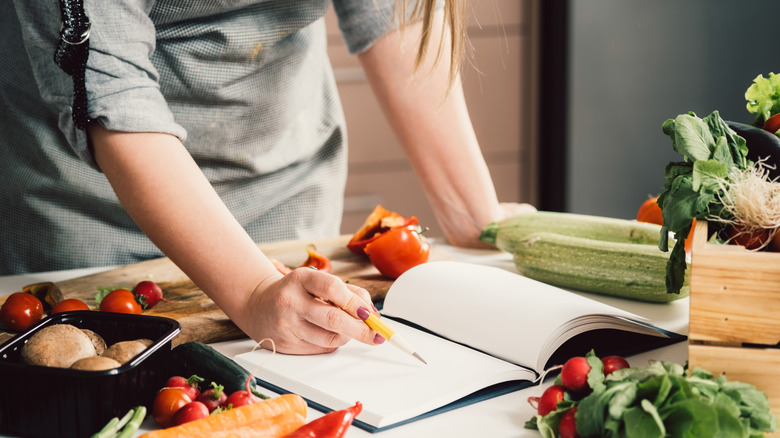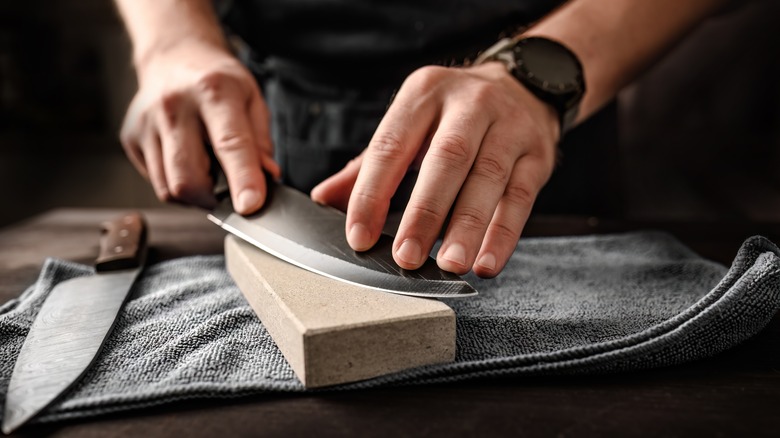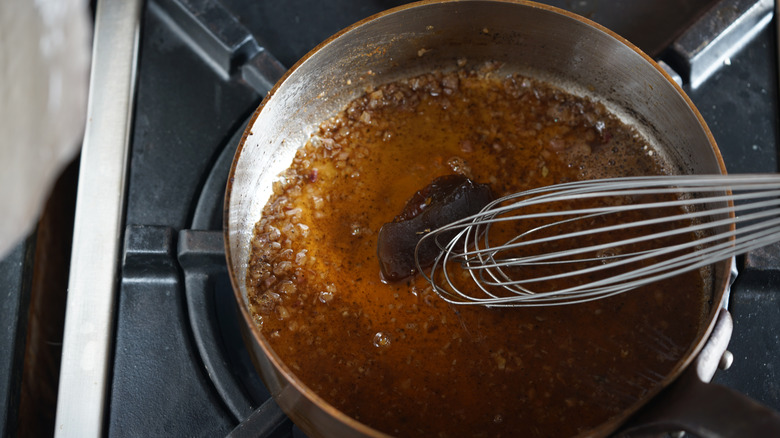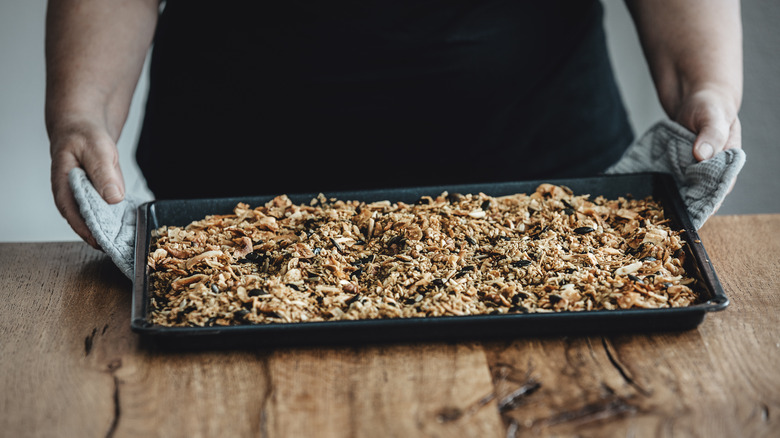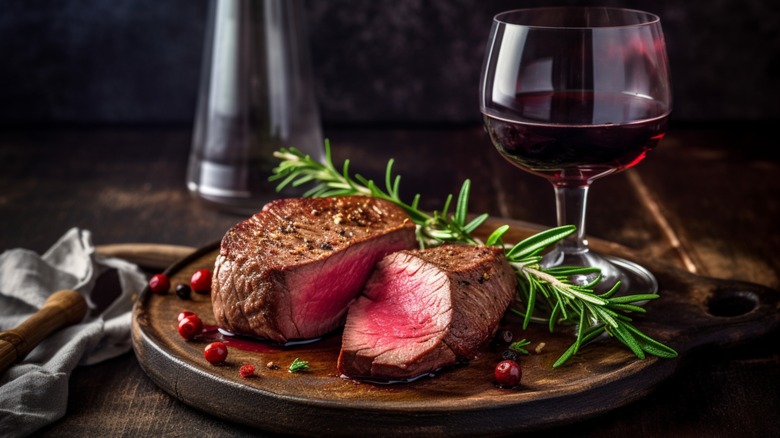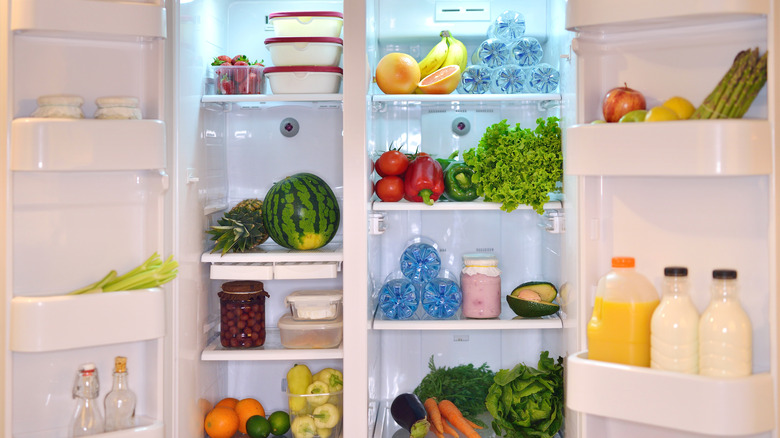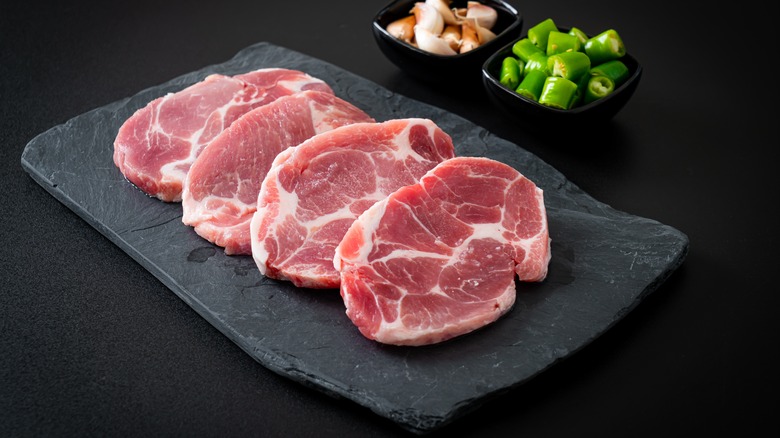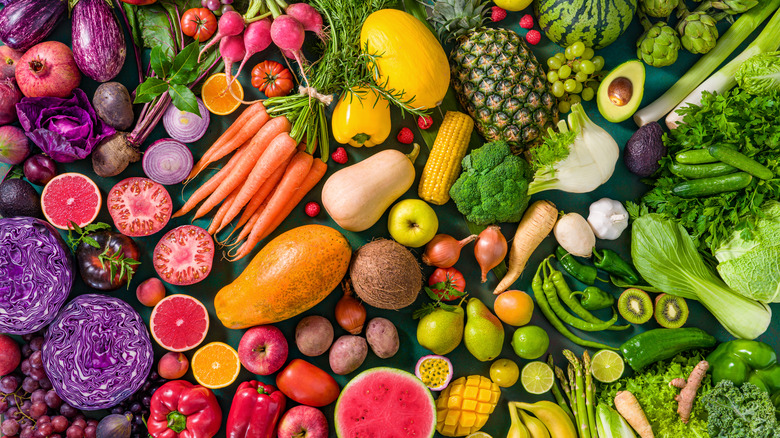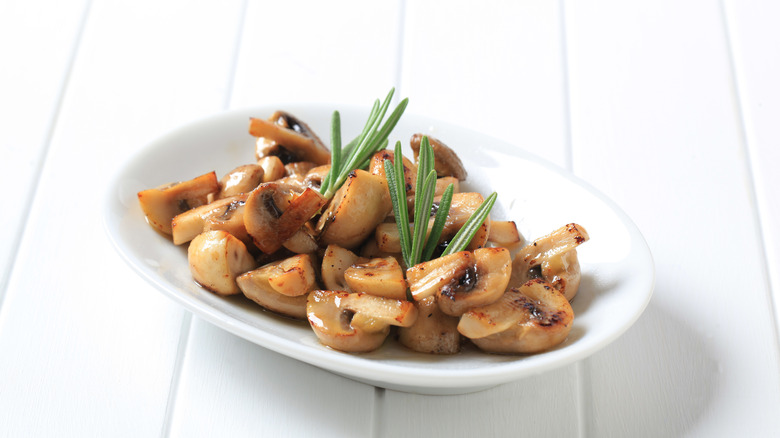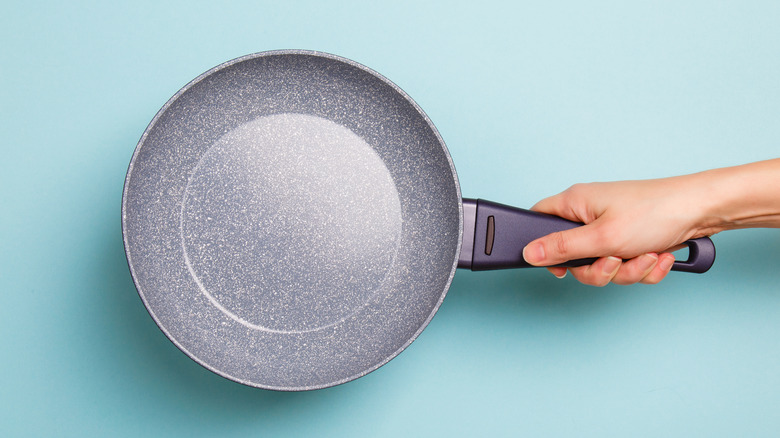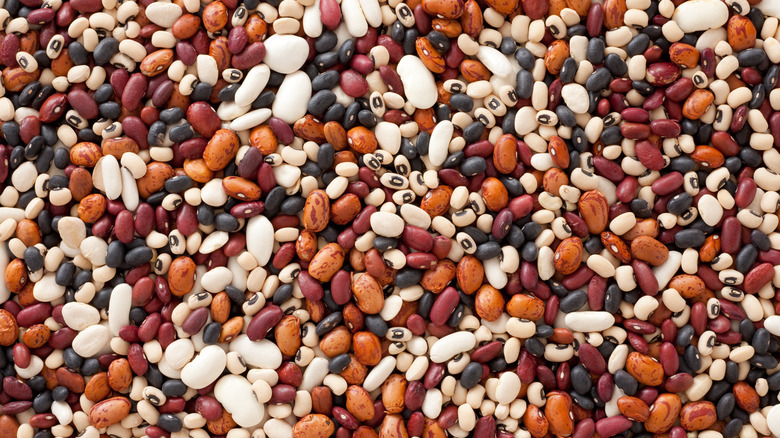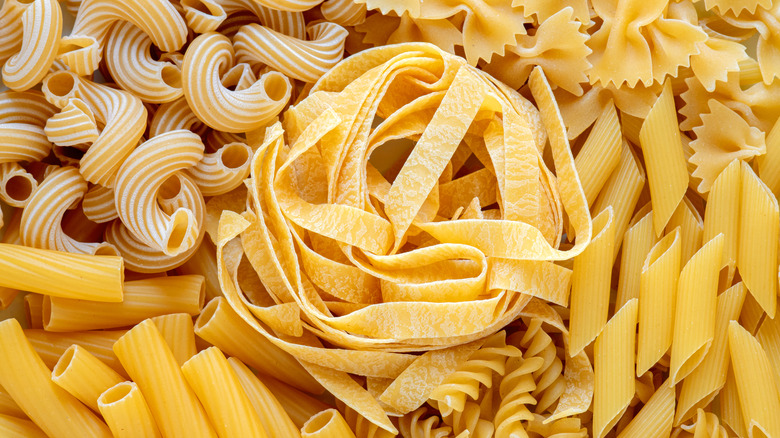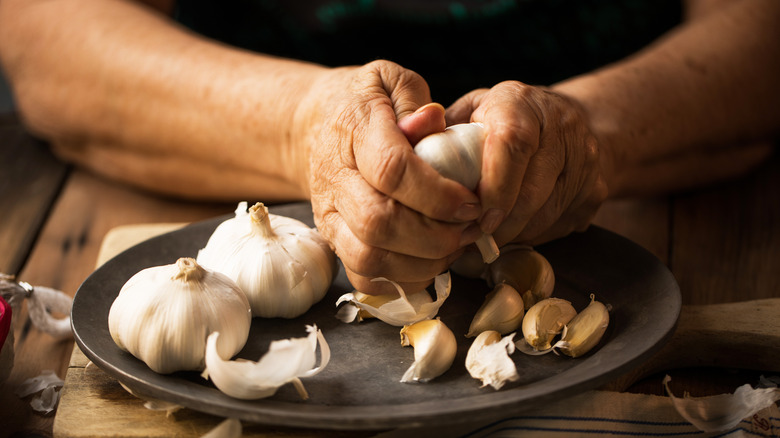Guy Fieri's Best Cooking Tips To Try In The Kitchen
You'd be hard-pressed to find a Food Network celebrity as ubiquitous as Guy Fieri. The goateed Mayor of Flavortown has been a mainstay on our screens since he won the second season of "The Next Food Network Star" in 2006 and, since then, he's gone on to Emmy-nominated success with "Guy's Big Bite" and "Diners, Drive-Ins and Dives," as well as fan favorites like "Guy's Grocery Games" and "Tournament of Champions." In 2023, he signed a $100 million deal with the network to remain its highest-paid star into 2026, ensuring that the Food Network and its spiky blond showman would remain synonymous for a while longer.
Although Fieri is not a classically trained chef, his culinary expertise dates back to his childhood when he insisted on spicing up his family's vegetable and brown rice diet with some good old-fashioned steak. He may be more well known for highlighting other people's cooking in shows like "Diners, Drive-Ins and Dives," but since his earliest days on television hosting "Guy's Big Bites," the larger-than-life star has been sharing his passion and skills in the kitchen. From knife etiquette to (of all things) his granola-making technique, here are Fieri's top cooking tips that you can bring into your own kitchen.
Practice your recipes ahead of time
It's natural to feel some nerves before hosting a dinner party. Not only do you have to carefully strategize how you're going to cook multiple dishes for a potentially large number of people and get them on the table at the right time, but you also want to make sure those dishes taste and look delicious. It's a daunting task, one that often leads to stress, exhaustion, and corner-cutting. But Guy Fieri has a tip for staying calm and confident even on big occasions: practice.
In an interview with EatingWell in which he shared tips and tricks about hosting Thanksgiving dinner, the Food Network star said, "One of the things that happens with people is that they get overwhelmed, and cooking is timing. So, I think one of the best things to do is to experiment or cook a couple of the recipes."
Practice, he explained, could involve anything from making stuffing as a side dish for a weeknight meal to brining and roasting a whole turkey. He even suggested familiarizing yourself with your oven since they can cook things unevenly and at different rates than what a recipe might prescribe. "Maybe don't do a full mock Thanksgiving," he conceded, "[B]ut giving everything a run-through is a good way to keep yourself from getting hung up when it's game day. "
Treat your knives with care
Guy Fieri has shown consistent financial savvy over the years, opening a string of restaurants, publishing books, and producing his lines of wine and tequila, but one of his most prominent business ventures outside of cable TV is his line of knives. The host has demonstrated his skills with the blade on multiple occasions, wowing the audience and costars as his hand becomes a blur of movement. But with great (and even average) knife skills comes great responsibilities to keep those sharp edges away from your skin.
Among Fieri's top rules for knife safety is his maxim to always clean and put away knives as quickly as possible. He argues that leaving them on the cutting board or in the sink increases the chances that someone might cut themselves. He also urges you to always walk with your knives pointing towards the floor. In addition to keeping yourself safe, you should also make sure to keep your knives in good condition, especially considering that a dull blade is more likely to lead to accidents. Sharpen your knives regularly and store them in a place where they won't be bent, broken, or in danger of cutting fingers.
Always deglaze your pans
Perhaps you've heard of deglazing, a technique that sounds impressive, professional, and maybe even a little bit technical. In practice, however, it's easy and you've probably been doing it this whole time without realizing it. Deglazing is when you add liquid to the pan to loosen and dissolve the debris at the bottom before taking it off the heat. If you tend to cook things on high heat until there's a solid brown film at the bottom of your pan that you have to scrub with the roughest sponge you have, deglazing will be your new favorite step in the cooking process. However, it benefits everyone, as the result of deglazing is a liquid full of delicious flavor and a pan that doesn't require excessive scrubbing.
One of the many fans of deglazing is Guy Fieri. In an appearance on Matthew McConaughey's Just Keep Livin YouTube channel in 2011, the Food Network Star called deglazing "probably one of the greatest techniques you can learn," explaining that it helps bring flavor off the bottom of the pan. You can deglaze with just about any liquid, even water and beer, but broth is a subtle yet flavorful option that complements many savory dishes.
Stir and rotate your granola
Despite the artery-clogging, carb-loaded meals you see Fieri devouring on "Diners, Drive-Ins and Dives," the bleach-blond host grew up in a household that ascribed to a much more health-conscious diet. Fieri says that his parents favored steamed fish and bulgar wheat over quarter-pound cheeseburgers and pound cake. While the future Food Network star eventually broke the mold and began making trips to the local butcher's shop, he still treasures a piece of cooking advice that he received from his mother about making granola.
"The top cooking trick I learned from my mom is to stir and rotate your granola," Fieri told TODAY Food in 2018, saying that she is his favorite granola chef to date and that he never appreciated it as much as he should have. "I learned my lesson on cooking granola when I was learning to cook from my mom on our old Franklin gas and wood fire stove," he continued, explaining, "It had incredible hot spots, which allowed the granola to burn easily. It was a really great lesson in keeping an eye on what you're doing."
Cook your steak with indirect heat
Getting a crispy sear on a steak is priority number one for many home cooks, but priority number two is to avoid overcooking. Yet sometimes, these two goals can seem incompatible. No matter how tender and juicy the center is, you aren't going to be happy if the outside has been cooked into tough leather.
As you might expect from a man who seems to consume more beef-related meals than any other person on TV, Guy Fieri has a solution. "What ends up happening is people try to cook a steak on this heat and cook it to medium-rare," he said in a 2016 video for SUCCESS magazine, gesturing to a smoking grill. "But by the time they get to medium-rare where it's pink in the middle, they've cooked the outside of it into beef jerky."
The solution, he explains, is to quickly sear the steak and then either finish it in the oven or cook it with another source of indirect heat. The method is similar to reverse searing — which some argue is the best way to cook steak — where you bake the steak in the oven and then sear it quickly before serving. Whichever order of operations you choose, you're more likely to end up with a steak that boasts a thin, seared layer and a deliciously rare, juicy center than you would if you did all the cooking on a hot grill.
Check the ingredients in your fridge
Food waste is a global problem that is costly, both financially and environmentally. According to the U.N.'s World Food Program, approximately one-third of all the food produced by humans is wasted even as people around the world go hungry. In the U.S., the issue is driven by multiple factors, including overbuying ingredients and cooking more food than necessary. On an individual level, this is worth avoiding purely for economic reasons. If you're purchasing more food than you need, some of it will end up getting spoiled and thrown out, and you'll have to buy it again, effectively paying for your meals twice.
There are many ways to mitigate food waste, such as making careful shopping lists so you don't end up impulsively buying items you won't eat and taking your restaurant leftovers home with you. But Guy Fieri's advice on the subject is simple. "Watch what's in your fridge," the host said in a 2020 interview with Tamron Hall. He added that, sometimes, when you limit yourself to being resourceful and creative with only a few ingredients, home cooks and professional chefs alike can end up with the best dish they've ever made.
Brine pork chops to keep them moist
Like all lean meats, pork chops are notorious for cooking up dry. They provide a good dose of protein, but unless you cook them just right, they will have a texture so rubbery that you might wish you'd skipped them altogether and prepared nothing but sides. Guy Fieri has another option that doesn't involve staring at a stopwatch. All you really have to do is plan ahead.
"You ask the majority of people about a pork chop and they go, 'Dry,' " Fieri told Matthew McConaughey on Just Keep Livin, explaining that brining the meat will change this misconception completely. When you soak pork chops in a tub of salt water, their protein structures weaken. This means that when you cook them, the proteins don't contract as powerfully and squeeze out as much liquid as they normally would when exposed to heat. They also absorb some of the water, adding more moisture and flavor to the final product.
You only need water and salt for brine, but Fieri recommends adding an equal amount of sugar as the salt, as well as peppercorns and garlic. Let the pork chops sit in the brine for at least an hour, then cook them in a skillet and you'll end up with meat so juicy you'll think it's pork loin.
Use quality ingredients
Guy Fieri probably isn't the first person you might think to turn to for advice on vegetables, but he has some strong feelings about how to make veggie-based dishes the most delicious they can be. When discussing the fully loaded baked potato soup that he tried during an episode of "Diners, Drive-Ins and Dives" — and loved so much that he recreated his own version — the host explained on Food Network's YouTube that you need to take extra care when purchasing ingredients. "Quality of the ingredients with something as simple as a soup are a must," he said, asserting that everything from the potatoes to the cream needs to be top-notch.
When it comes to purchasing meat, Fieri was equally forthright: "You know, one of the things that you need to have in your life," he said, "You need to have a good dentist. You need to have a really good attorney, a really good bail bondsman, and a really great butcher ... maybe not in that order."
He went on to explain that when he's planning to make a prime rib, he calls his butcher a couple of weeks in advance to get the dry-aging process going. Most of us aren't planning our meals weeks ahead, but having a few suppliers who you know sell top-notch ingredients and who will put real time and care into your food will pay dividends when it comes to the outcome of your recipes.
Use the microwave for mushrooms
There are many ways to cook mushrooms, including sauteing, grilling, and braising, but if you're asking Guy Fieri, you're likely to hear an unlikely option: microwaving. This unglamorous move might shock a Michelin-starred chef or a dedicated home cook, but when you want to get your mushrooms cooked quickly, such as when you're planning to put them on a burger, the truth is that a trip in the microwave is a no-nonsense and very viable move.
As the TV host told an audience during a live cooking demonstration in 2021 (via Food & Wine), microwaving mushrooms ensures that they release all their moisture and reach the desired texture in no time. Simply wrap them in plastic and hit the start button. As a bonus, you get to keep the liquid they give off as they cook. This flavorful, umami-rich broth can be used in a variety of ways, including for deglazing pans, steaming rice, and making vegetable soup.
Invest in non-stick pans
There is a seemingly infinite number of kitchen gadgets and utensils you can buy, from banana slicers to hamburger presses. In many cases, these tools are a redundant waste of money that only clutter your kitchen drawers. But when it comes to the essentials, such as pans and knives, it's worth investing in high-quality products.
Guy Fieri recommends using non-stick pans, especially if you're a beginner. "I'll tell you something," he said in a 2011 cooking demonstration with Matthew McConaughey on the actor's Just Keep Livin YouTube channel, "If you don't have a lot of experience in cooking — worried about burning things, worried about sticking — non-sticks work really well for the beginner cook."
Not only do they save you the hassle of having to scrape burned food off the bottom of the pan, but they also allow you to use less oil than you would if you were using a regular pan. Just make sure that you don't heat them on high since the chemical coating that prevents food from sticking will start to vaporize and become potentially toxic.
Always start with dry beans
Along with sliced bread, canned beans are one of the most useful food-based innovations of the past couple of centuries. Instead of having to soak dry beans for a full day, you can simply pull out a can opener and start spooning them into your mouth (or heat them in a pot if you're feeling fancy). Because of this, beans are one of the quickest proteins you can prepare, and most of us don't think twice about choosing canned over dried. But the same cannot be said of Guy Fieri. The Food Network star is passionate about using dried beans, and he has a good case for why you should be too. When discussing his love for bean salad, he said, "[If] you really want to get the most out of a bean salad, go with your beans from dry," explaining that they provide a more toothsome flavor (via Food Network).
There is more than personal preference on Fieri's side. Cooking beans from dry gives you greater control over the texture, meaning you can take them off the heat when they're still firm and perfect for a refreshing bean salad. Dried beans also allow you to add flavor. You can always add herbs to canned beans, but when you cook dried beans in a liquid full of aromatic ingredients, the beans are infused with a complex array of tastes that you can't reverse engineer.
High-quality pasta is worth every penny
Pasta is one of those kitchen staples that you might not think much about. Like rice, it's the kind of item you grab from the supermarket shelf almost at random, as long as it's the variety you like. When most of us buy pasta, we're thinking about the variety of pasta shapes. Quality is less of a concern since the ingredients seem so straightforward.
But for Guy Fieri, that quality is everything. When demonstrating his recipe for bacon and tomato pasta, he said, "Great pasta is the foundation to this dish. What I want you to think about when it comes to pasta — I'm not saying great pasta by the dollar amount, I'm saying by the look. We want to get the pasta that's been air-dried. So, the pasta that looks a little bit more artisan, a little bit more crusty and old — and it usually does cost a bit more — it's worth every penny" (via Food Network).
Traditional pasta is dried at a low temperature (around 100 degrees Fahrenheit) for 30 hours or more. Industrially produced pastas are dried at higher temperatures (sometimes as high as 200 degrees) for the sake of efficiency. In such high heat, the pasta begins to toast, losing some of its taste, smell, and nutritional value. Because it takes longer to produce, slow-dried pasta is more expensive but has an even texture and fresh flavor.
Add garlic last
Garlic is the dominant flavor in many recipes, but it is also a delicate ingredient that needs to be incorporated with care. Unlike onions, which can cook in high temperatures without burning, garlic is quick to tip over into charred territory. Perfectly cooked garlic is a mouthwatering and transformative addition to a recipe, but once it's overcooked, garlic turns bitter and infuses the rest of the ingredients with its off taste. Guy Fieri's solution is to wait to add this all-important ingredient until late in the cooking process, no matter what the recipe tells you. "If you want to do it wrong, do the garlic first," he told an audience during a live cooking demonstration in 2021 (via Food & Wine). "Always onion first. Garlic goes in last, as soon as it gets nutty caramel, add liquid."
This directive might seem questionable considering the fact that many recipes call for the garlic to be added directly after the onion, but as Fieri attests, this common order of operations can be a mistake. Garlic has a much lower proportion of moisture than onions and is usually sliced much more thinly, two factors that make it burn faster. It also needs less time to cook than other vegetables, such as sliced zucchini and mushrooms. If you're cooking over high heat and your garlic is finely minced, even 30 seconds may be too long.

